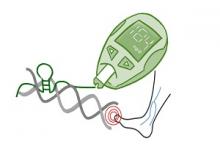- About us
- Research
- Students & Teaching
- Seminars & Events
- Directories
- Booking Rooms & Equipment
- עברית
Home » Prof. Soreq & Dr. Meydan - mechanisms behind neural disease associated with diabetes
New research underlines the mechanisms behind neural disease associated with diabetes. The analysis, published in Neuroscience Letters, examined recent studies of a novel family of molecules operating in cells, called Non-Coding RNAs (ncRNAs). This vast family of molecules includes small and larger chains of nucleic acids that, as opposed to the better-known messenger RNA (mRNA), do not get translated into proteins via the “genetic code”. Instead, they affect the machinery used to process that code, thereby regulating how this code influences the function of cells, tissues and organs. In that sense, ncRNAs serve as another form of control over various cellular functions. Unlike direct protein production processes, which have been explored since DNA models emerged in the 1950’s, ncRNAs have been studied only in the past few decades. Nevertheless, they are gaining a central position in today’s research, since they have been implicated in an ever-expanding set of roles that include malignancy, heart problems, and brain diseases such as Alzheimer’s Dementia.
In the current publication, the authors explore ncRNAs that have been previously implicated in a troublesome neural complication in diabetics. This condition, called diabetic neuropathy, reflects disease-associated death of peripheral neurons. It affects as many as 50% of diabetics over the long term, and may lead to pain, limb infections, and amputations. By cross-linking and reviewing accumulating information, Meydan et al. point to the involvement of a tightly associated destructive pattern – that of inflammation, which is inherent in various pathological processes. Inflammation is brought forward in accumulating research as embedded in diabetes, and it is therefore of no surprise that inflammation-associated ncRNAs appear to be involved in diabetic neuropathy as well.
Highlighting ncRNAs in diabetic neuropathy expands our understanding of diabetes through the prism of inflammation, and reveals how the medical community may counter diabetes and its complications. In the future, the scientific and medical communities may look at several ncRNAs in diabetic patients, and learn about the pattern of their disease from their ncRNA expression profile. This ncRNA “signature” may have potential ramifications for their management and prognosis, especially in earlier stages of diabetes when patients may enjoy from state-of-the-art interventions towards glycemic/metabolic control.
This research was performed in collaboration with Prof. Nurcan Üçeyler from Wurzburg, Germany.
